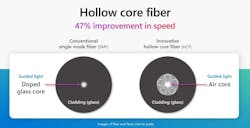Don’t stop thinking about tomorrow, of fiber
Key Highlights
- Fiber speeds are rapidly increasing, with standards like 25G and 50G PON enabling multi-gigabit services and supporting 5G deployments.
- Emerging technologies such as 200G PON and 50,000 Gbps speeds on existing fiber are set to dramatically boost network capacity and performance.
- Hollow-core fiber offers faster data transmission with lower latency, and Microsoft is deploying extensive hollow-core fiber networks for cloud services.
- AI and agentic platforms are revolutionizing network management, enabling automation, zero-touch operations, and personalized bandwidth prioritization.
- Network slicing allows for dynamic, on-the-fly allocation of bandwidth and security, enhancing user experiences for remote work, gaming, and financial transactions.
By Gary Bolton / Fiber Broadband Association
It’s difficult to keep up with how fast fiber might go, but the upside for the next decade is jaw-dropping, even with today’s multi-gig speed services delivered on the same glass strands installed decades ago. Faster speeds also open more options for service providers to differentiate themselves and improve their back-office operations.
Today’s essential standard for most service providers is XGS-PON (10 Gbps Symmetric), providing the platform for delivering multi-gig packages up to 8 Gbps. For those on the leading edge, such as EPB and GFiber, 25G PON is being brought into use, providing speeds of up to 20 Gbps. The arrival of 25G PON comes at an opportune time, providing support for faster 5G cellular deployments that are already pushing the bounds of existing networks.
Next year, 50G PON will fully come into the market, with carriers able to pick and choose from a 25G/50G upgrade path or going straight to 50G PON without an intermediate stop. The ultimate winners in this decision are the customers, who will have different and more affordable options for every increasing speed, and service providers who will be able to more effectively mix and match consumer and business services on the same network.
As 25G and 50G PON expand their reach into networks worldwide, the fiber industry is working towards the next PON speed increase. Initial discussions focused on a path from 50G to 100G PON, but 200G PON has emerged as a potential industry standard for implementation and introduction into the market over the next decade.
Ludicrous speeds ahead
More speed gains out of fiber are also on the horizon. CableLabs has demonstrated and established standards for 100G and 200G coherent PON speeds on a single wavelength up to 80 kilometers, but those feats pale to what the organization has done in its advanced fiber lab.
Speeds of up to 50,000 Gbps have been achieved on a single strand with “the fiber you already have in the ground,” said CableLabs CTO Phil McKinney.
McKinney provided a few other details as to exactly how the 50,000 Gbps speed was reached or how much the equipment might cost when translated from lab experiment to real-world implementation, with more details to be announced in the future. Such a feat is especially intriguing given that Ciena is lighting up intercontinental fiber links around the world at speeds of up to 1.6 Tbps using state-of-the-art optics and silicon on 20-year-old fiber under the sea.
We are also starting to see the production of hollow-core fiber ramp up for specialized use in data center connectivity.
In September, Microsoft made several announcements on how it is moving hollow-core technology into production use and at scale, planning to deploy 15,000 kilometers of hollow-core fiber across its Azure data center network.
Hollow-core fiber provides a space for light to travel along, enabling it to travel 45% faster than traditional glass fiber, as well as reducing latency by 33% and reducing the need for amplification. The space also enables the use of more optical wavelengths for data transmission, so a single hollow core strand could conceivably crush the current 50,000 Gbps CableLabs accomplishment down the road.
Open highways, unlimited opportunities
“Nobody needs that much broadband” is cliché and shortsighted. Just as with the electric grid, peak broadband capacity is critical to performance (not sustained or average speeds).
One person’s usage is different from another household’s or business’s wants and needs. I would have never thought that a cherry farm would use a 25G PON connection. Still, New Zealand Cherry Corp streams 400,000 high-resolution photos per hour for analysis, enabling it to assess the quality and maturity of the crop on the trees in real time.
It expects to nearly triple its harvest over time by leveraging AI, the cloud, and high-speed, low-latency broadband.
AI is taking every sector to a new level, with steadily increasing broadband needs to deliver information into the data center for processing and the resulting insights, such as better cherry crop yields. It’s not hard to imagine a future where that single cherry farm talks to multiple AIs in order to sell its crop at a premium while providing real-time data to financial markets and government organizations on its performance, resulting in better forecasting and statistics on economic performance.
What AI can do for service providers and their customers promises to revolutionize the broadband industry. Agentic AI, such as Calix’s recently announced platform, will dramatically simplify operations, provide deeper and faster insights, and accelerate the development and deployment of new services. Agents can help service provider call centers for better marketing and sales, help resolve billing issues, and identify and fix network problems with faster resolutions.
Adding AI to quickly resolve billing issues and identify and fix network problems faster is only the first step in unburdening staff from mundane tasks that often bog them down to the detriment of their efficiency and overall customer satisfaction. The ultimate goal on the operations side is to get to a true zero-touch network, with AI handling everything from customer turn-up and onboarding through daily network tuning and problem resolution.
Among the agentic work in progress is a fully automated configuration and optimization for third-party devices connected to the home network, so that something critical like a home heart monitor would have priority on the network over a doorbell video camera if the network were overloaded.
But enabling AI for network tasks means having enough bandwidth to do the background work without affecting the overall customer experience. Agents need to be able to understand the network environment and the applications customers are using, and seamlessly adjust performance and security settings to deliver the optimum experience without having to dig through an app or having someone at a call center manually adjust settings until the proper outcome emerges.
Agentic AI ties in neatly with the revised interest in network slicing, where specific user functions and applications can be assigned bandwidth, priority, and increased security over everything else that is taking place on the network. Remote workers will want priority for video calls during working hours, while gamers want their applications at the top when in the middle of play sessions. Financial institutions and their customers alike would welcome a combination of priority access, direct connections between server and customer endpoint, and enhanced encryption when transactions are taking place, while future applications such as AI and VR will likely need their own customizations.
Over the summer, GFiber announced its work with Nokia to implement network slicing and has discussed plans to offer it as a feature bundled in with high-speed broadband packages that give customers more flexibility and control over connections.
Implementing network slicing on a broad scale would require a high level of automation in terms of implementation and daily use, since network performance and connections would be adjusted on-the-fly as needed, tasks which have been handled in the past by specialized staff in a network operation center. Implementing network slicing for large-scale consumer use will require very simple options and controls accessible via a web application, with the heavy lifting done by AI in the background.
Don’t stop
The second verse of “Don’t Stop” by Fleetwood Mac could be applied every day to the fiber broadband industry. “Don't stop thinking about tomorrow, don’t stop, it'll soon be here, It'll be better than before.”
We aren’t quite at the last line of “Yesterday’s gone,” but service providers continue to retire legacy copper and TDM switches, much of the cable industry is embracing fiber deeper into their HFC networks and new builds, while we know many wireless ISPs who are deploying fiber because they know it’s tomorrow and is better than before.
Whatever your network today, I can tell you that fiber is your tomorrow, and it’ll continue to be better than before in the years and decades to come.
Gary Bolton is the CEO of the Fiber Broadband Association.






